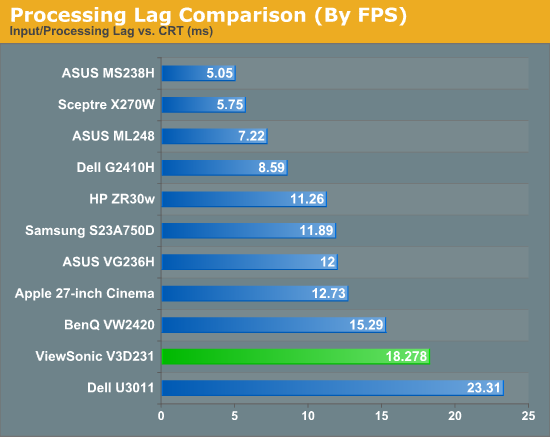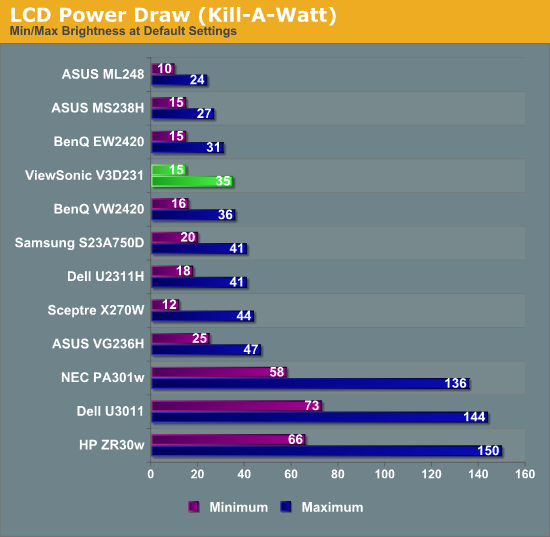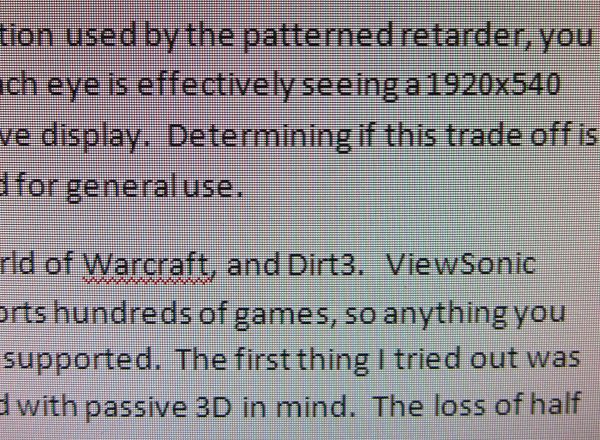ViewSonic V3D231 3D Display - The Passive Approach
by Chris Heinonen on December 30, 2011 12:00 AM ESTOf course anyone buying this ViewSonic monitor is going to be buying it for 3D use as well. As I touched upon earlier, passive 3D has some advantages over active 3D, including cheaper glasses. The main advantage in my view is that I find it far easier to watch and enjoy than active 3D. For people like myself, the opening and closing of the lenses in active 3D glasses leads to headaches and discomfort in a short period of time, and we generally avoid it. Passive 3D has none of that since your lenses are always open. This also allows more light to pass through than with an active 3D display. Additionally the technology used in passive 3D should virtually eliminate any ghosting or crosstalk in the 3D image.
Unfortunately, passive 3D does have one major downside: due to the polarization used by the patterned retarder, you only get half the effective vertical resolution from a display. Each eye is effectively seeing a 1920x540 image instead of a 1920x1080 image as you would with an active display. Determining if this tradeoff is worth it requires trying out both types of display, both for gaming and for general use. Examples of text from this review can be seen below, both with and without the glasses between the camera and screen.
For gaming tests, I relied on three main games: Half Life 2, World of Warcraft, and DiRT 3. ViewSonic provides the TriDef 3D software with the monitor that supports hundreds of games, so anything you have from the past few years has a very good chance of being supported. The first thing I tried out was World of Warcraft, and this was certainly not a game designed with passive 3D in mind. The loss of half the resolution renders the text unreadable, which is a big no-no in an MMORPG or other genre with lots of reading. During normal gameplay it was fine, but you can’t read anything that is on the screen while in 3D mode and wearing the glasses.
Half-Life 2 and DiRT 3 prove to be much better examples for the V3D231, as there is a good sense of depth in the rendering and not much in the way of artifacts. You still see some ghost objects, but I found the glasses much easier to wear and use than any active 3D glasses. The TriDef software allows for you to adjust the sense of depth and other 3D parameters in game, which lets you determine what is easiest to view. Objects that appear to come out of the screen, instead of going back into the screen, can often cause more eye strain and fatigue, so if you find yourself getting tired you can reduce the level of depth in the image to compensate. While I think that 3D can add something to the experience, passive 3D does add a lot of aliasing due to the loss of vertical resolution, and I feel that a 120Hz refresh rate made for a more natural, immersive experience than passive 3D does.
For watching movies, passive 3D is a tossup once again. The recent 3D Blu-ray release of The Lion King looked just fantastic. Crosstalk and ghosting were practically non-existent I found, and the loss of resolution really didn’t bother me much with the animation. However, as soon as I put on the 3D Blu-ray of Tron Legacy, I found myself wishing for an active 3D display. The combination of black backgrounds and bright, angled lines led to aliasing all over the image and was really quite distracting. Tron is my worst case disc for passive 3D, as it seems to show off the downsides more than anything else, and that is the case here.
Running crosstalk benchmarks, the ViewSonic seems to do much worse than the prior active 3D Samsung, but the results on the ViewSonic are incredibly dependent on my head angle and location. If I shift just an inch to the side I get totally different numbers, so I tried to maintain my head in the dead center. Since it is a passive display, the numbers seem much higher than they should be, but I made certain that every measurement was as accurate as I could make it.

For non-3D gaming, I put the ViewSonic through the usual lag tests, with both faster and regular response enabled. I found no differences between the modes in testing, so there is only one set of numbers presented here. The ViewSonic averages just about 1 frame of lag in comparison to the ViewSonic CRT next to it. I had no issues using it for general gaming, but people that need better response will want to look at some other options.

Hooked up to the Kill-A-Watt, the ViewSonic maxes out at 35 watts with a full backlight, and 15 watts with the backlight at minimum. This is higher than other TN displays with LED backlights and closer to IPS or VA panels. Given the higher power usage I wish the light output had been higher than it is.













42 Comments
View All Comments
MobiusStrip - Monday, January 9, 2012 - link
"as most monitors will be used with web pages, word processors, and spreadsheets, there are a lot of white backgrounds that will accentuate it."Yep, because of the continued use of failed inverse-video color schemes from the "desktop publishing" fad, during which vendors wanted to draw an analogy between the screen and a sheet of paper. That analogy fails because a sheet of paper doesn't EMIT light, the way a screen going full-blast in your face does.
At least with most OSes you can set up a color scheme that makes sense, with a dark background and light text. Mac users are SOL, since the vaunted Mac UI still doesn't have user-definable color schemes (which Windows has had for 20 years).
RPsen - Sunday, January 28, 2018 - link
I love premium sound of ViewSonic V3D231, because it has SRS for high quality sound.Admin: http://projectoreviews.com